Exergy Evaluation of a Heat Supply System with Vapor Compression Heat Pumps
Abstract
1. Introduction
2. Literature Review
3. Exergy Model of a Vapor Compression Heat Pump
- Flux of exergy entering the control volume of a thermodynamically open system, (W)
- Flux of useable exergy leaving the control volume of a thermodynamically open system, (W)
- Flux of internal exergy losses of a thermodynamically open system, (W)
- Flux of external exergy losses of a thermodynamically open system, (W)
- Flux of change of exergy of an external heat source being in contact with a thermodynamically open system, (W)
- Mass flow of heating water through the condenser, (kg/s)
- Specific heat of water, (J/(kgK))
- Temperature of water entering the condenser, (K)
- Temperature of water leaving the condenser, (K)
4. Case Study Description
5. Case Study—Exergy Evaluation
Model of the Heat Supply System with Heat Pumps
6. Calculations
- Mass flow of the heat transfer medium, (kg/s)
- Specific heat of the heat transfer medium, (J/(kgK))
- Temperature of the heat transfer medium entering the ground heat exchanger, (K)
- Temperature of the heat transfer medium leaving the ground heat exchanger, (K)
7. Results and Discussion
7.1. Exergy Analysis of the Actual System
7.2. Solution 1—Part of the Electricity Demand Covered by a Renewable Energy Source
7.3. Solution 2-Low-Temperature Emission System for Heating
7.4. Solution 3—Heat Pump Replaced by a Heat Exchanger Connected to a District Heating Network Supplied from an Energy-Efficient CHP Plant
- Annual co-generation factor, 0.3 (as for typical coal-fired CHP plant in Poland)
- Electrical power produced in the CHP plant in co-generation with heat, (W)
- Heat flux produced in the CHP plant in co-generation with electricity, (W)
- Total driving energy required for the CHP plant operation, (W)
- Energy efficiency of the CHP plant, 0.80
- Driving energy used for the heat production in the CHP plant, (W)
- Energy efficiency of the electricity production and distribution system, 0.33
- Driving exergy used for the heat production in the CHP plant, (W)
- Ratio between specific chemical exergy of the fuel used in CHP plant and its low heating value, 1.09
8. Conclusions
Author Contributions
Funding
Acknowledgments
Conflicts of Interest
Nomenclature
| Exergy flux, (W) | |
| Specific heat, (J/(kgK)) | |
| Annual co-generation factor, (-) | |
| Specific enthalpy, (J/kg) | |
| Mass flow, (kg/s) | |
| Electrical power, (W) | |
| Heat, (J) | |
| Specific entropy, (J/kgK) | |
| Temperature, (°C) | |
| Temperature, (K) | |
| Ratio between specific chemical exergy of the fuel used in electricity production and its low heating value, (-) | |
| Loss, (-) | |
| Change, (-) | |
| Efficiency, (%) | |
| Time, (h) | |
| Indices | |
| Compressor | |
| Condenser | |
| Circulating pump | |
| District heating | |
| Driving | |
| Electro-mechanical | |
| Evaporator | |
| External | |
| Expansion valve | |
| Ground | |
| High-temperature | |
| Heat pump | |
| Heat source | |
| Internal | |
| Entering | |
| Low-temperature | |
| Mixing | |
| Reference | |
| Leaving | |
| Electricity production | |
| Return | |
| Supply | |
| System | |
| Useable | |
| Water | |
| Glycol | |
| Primary | |
References
- Schmidt, D. Low exergy systems for high-performance buildings and communities. Energy Build. 2009, 41, 331–336. [Google Scholar] [CrossRef]
- Cakir, U.; Comakli, K. Exergetic interrelation between an heat pump and components. Appl. Therm. Eng. 2016, 105, 659–668. [Google Scholar] [CrossRef]
- Li, R.; Ooka, R.; Shukuya, M. Theoretical analysis on ground source heat pump and air source heat pump systems by the concepts of cool and warm exergy. Energy Build. 2014, 75, 447–455. [Google Scholar] [CrossRef]
- Esen, H.; Inalli, M.; Esen, M.; Pihtili, K. Energy and exergy analysis of a ground-coupled heat pump system with two horizontal ground heat exchangers. Build. Environ. 2007, 42, 3606–3615. [Google Scholar] [CrossRef]
- Verda, V.; Cosentino, S.; Lo Russo, S.; Sciacovelli, A. Second law analysis of horizontal geothermal heat pump systems. Energy Build. 2016, 124, 236–240. [Google Scholar] [CrossRef]
- Habtamu, M.B.; Torger, B.; Bye, P.F.; Erlend, A. Parametric study of a vertically configured ground source heat pump system. Energy Procedia 2017, 111, 1040–1049. [Google Scholar] [CrossRef]
- Abbasi, Y.; Baniasadi, E.; Ahmadikia, H. Performance Assessment of a Hybrid Solar-Geothermal Air Conditioning System for Residential Application: Energy, Exergy, and Sustainability Analysis. Int. J. Chem. Eng. 2016, 2016, 1–13. [Google Scholar] [CrossRef]
- Hu, P.; Hu, Q.; Lin, Y.; Yang, W.; Xing, L. Energy and exergy analysis of a ground source heat pump system for a public building in Wuhan, China under different control strategies. Energy Build. 2017, 152, 301–312. [Google Scholar] [CrossRef]
- Menberg, K.; Heo, Y.; Choi, W.; Ooka, R.; Choudhary, R.; Shukuya, M. Exergy analysis of a hybrid ground-source heat pump system. Appl. Energy 2017, 204, 31–46. [Google Scholar] [CrossRef]
- Ozgener, O.; Hepbasli, A. Modeling and performance evaluation of ground source (geothermal) heat pump systems. Energy Build. 2007, 39, 66–75. [Google Scholar] [CrossRef]
- Cho, H. Comparative study on the performance and exergy efficiency of a solar hybrid heat pump using R22 and R744. Energy 2015, 93, 1267–1276. [Google Scholar] [CrossRef]
- Bi, Y.; Wang, X.; Liu, Y.; Zhang, H.; Chen, L. Comprehensive exergy analysis of a ground-source heat pump system for both building heating and cooling modes. Appl. Energy 2009, 86, 2560–2565. [Google Scholar] [CrossRef]
- Hepbasli, A. Exergetic modeling and assessment of solar assisted domestic hot water tank integrated ground-source heat pump systems for residences. Energy Build. 2007, 39, 1211–1217. [Google Scholar] [CrossRef]
- Saloux, E.; Sorin, M.; Teyssedou, A. Modeling the exergy performance of heat pump systems without using refrigerant thermodynamic properties. Energy Build. 2016, 112, 69–79. [Google Scholar] [CrossRef]
- Stanek, W.; Simla, T.; Gazda, W. Exergetic and thermo-ecological assessment of heat pump supported by electricity from renewable sources. Renew. Energy 2019, 131, 404–412. [Google Scholar] [CrossRef]
- Mróz, T.M. Energy Management in Built Environment—Tools and Evaluation Procedures; Publishing House of Poznań University of Technology: Poznań, Poland, 2013; ISBN 978-83-7775-238-8. [Google Scholar]
- Szargut, J. Sequence method of determination of partial exergy losses in thermal systems. Exergy Int. J. 2001, 1, 85–90. [Google Scholar] [CrossRef]
- Szargut, J. Exergy. Calculation and Application Handbook; Wydawnictwo Politechniki Śląskiej: Gliwice, Poland, 2007; ISBN 978-83-7335-438-8. [Google Scholar]
- PN-76/B-03420—Wentylacja i Klimatyzacja. Parametry Obliczeniowe Powietrza Zewnętrznego; Polish Committee for Standarization: Warsaw, Poland, 1976. [Google Scholar]
- Ministry of Investment and Economic Development. Dane do Obliczeń Energetycznych Budynków. 2018. Available online: https://www.miir.gov.pl/strony/zadania/budownictwo/charakterystyka-energetyczna-budynkow/dane-do-obliczen-energetycznych-budynkow-1/ (accessed on 6 May 2018).
- Solkane Refrigerants 8.0. Available online: https://solkane-refrigerants.software.informer.com/8.0/ (accessed on 25 May 2018).
- Rozporządzenie Ministra Infrastruktury i Rozwoju w sprawie metodologii wyznaczania świadectw charakterystyki energetycznej budynku lub części budynku oraz świadectw charakterystyki energetycznej; Polish Ministry of Infrastructure and Development: Warsaw, Poland, 27 February 2015.
- Mróz, T.M.; Dutka, A. Exergy–economic evaluation of heat recovery device in mechanical ventilation system. Energy Build. 2015, 86, 296–304. [Google Scholar] [CrossRef]
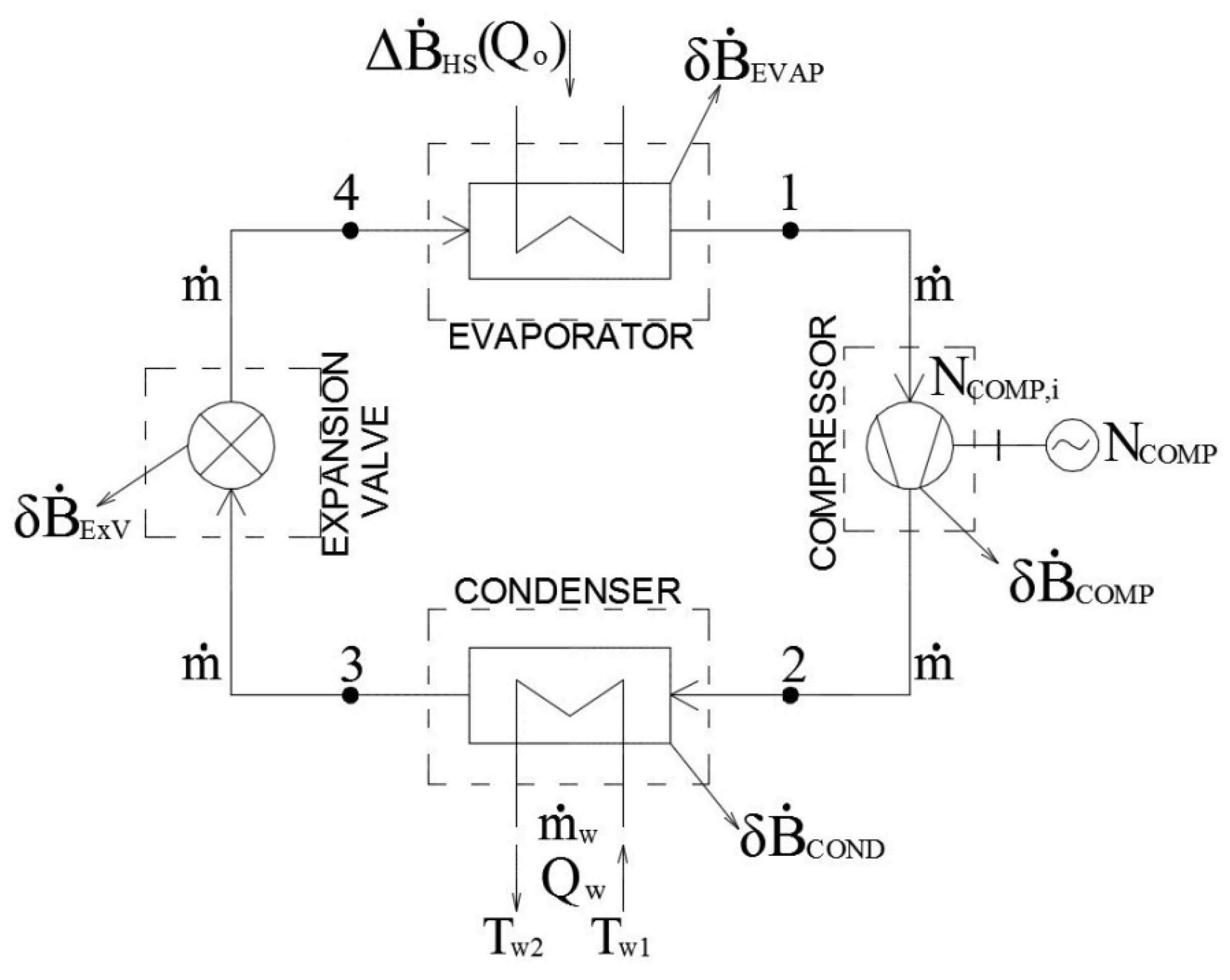
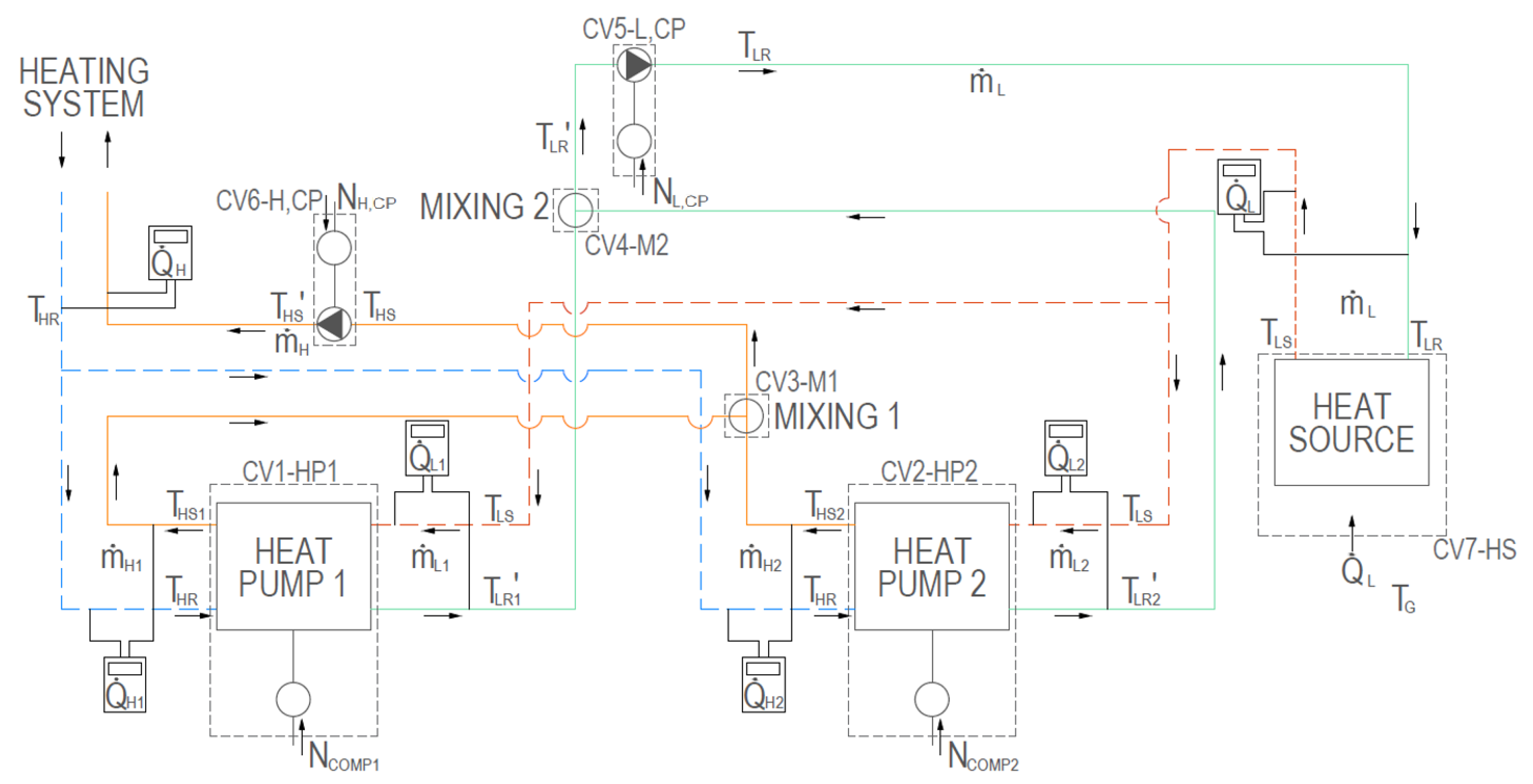
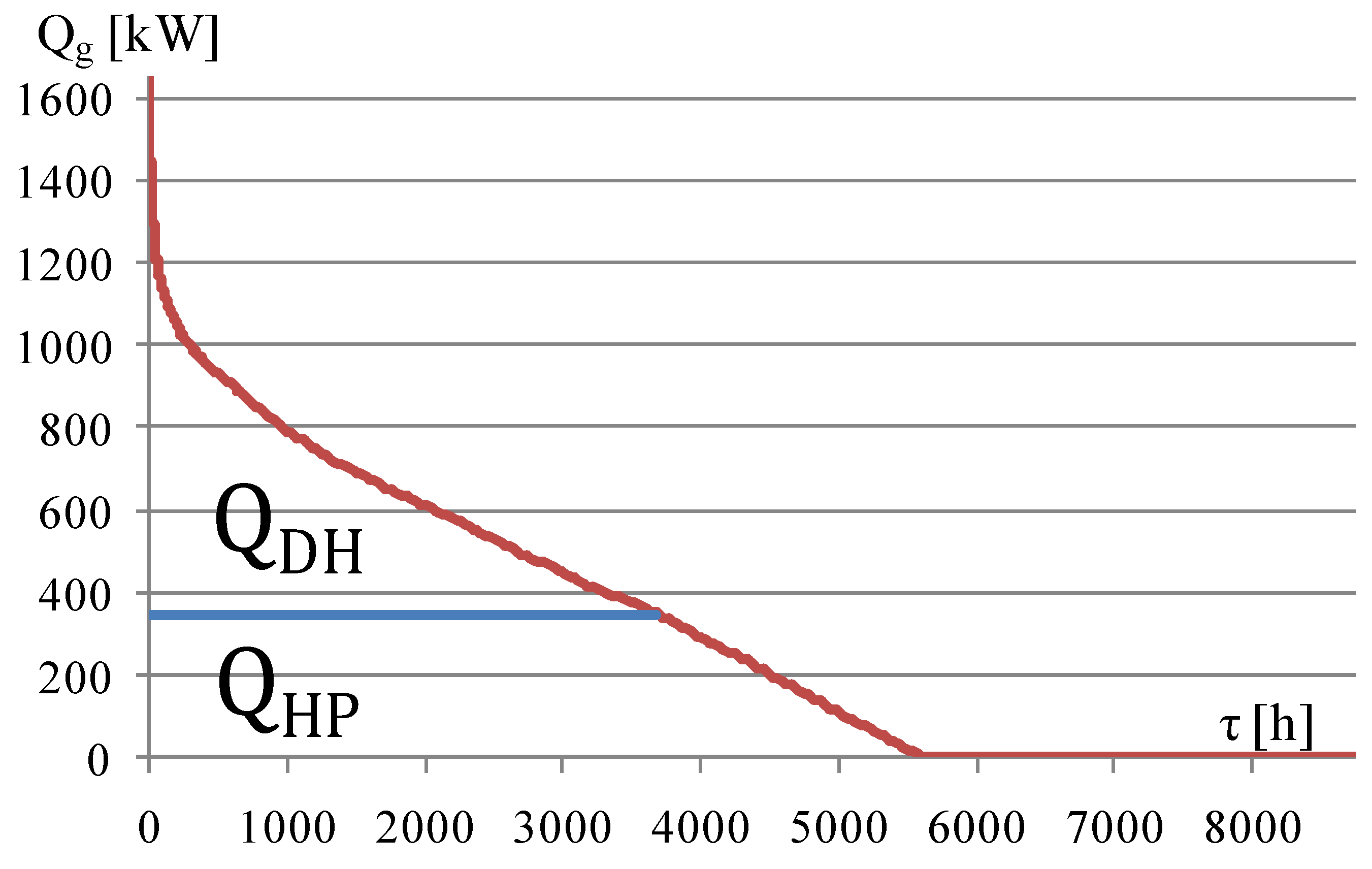
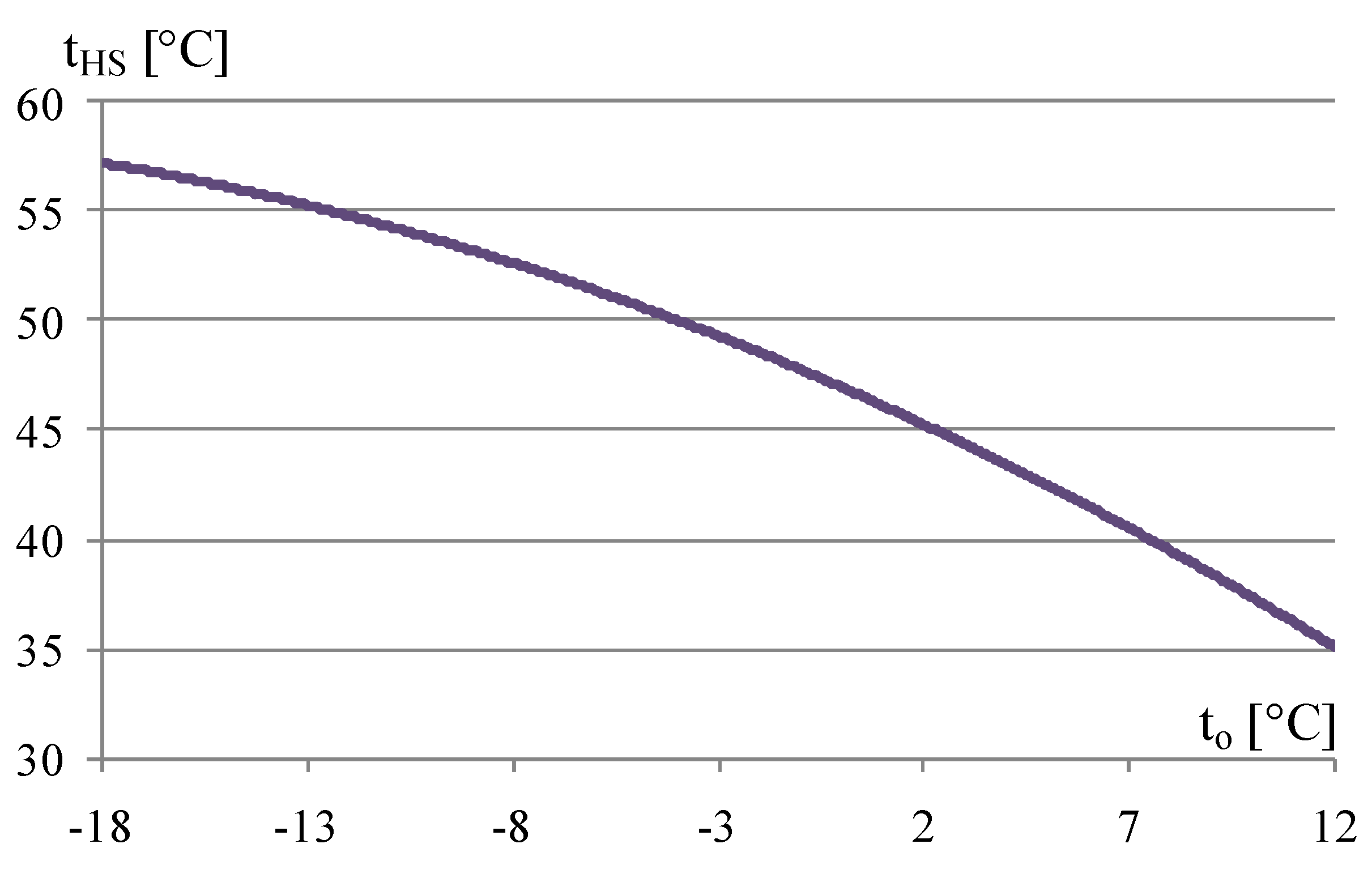
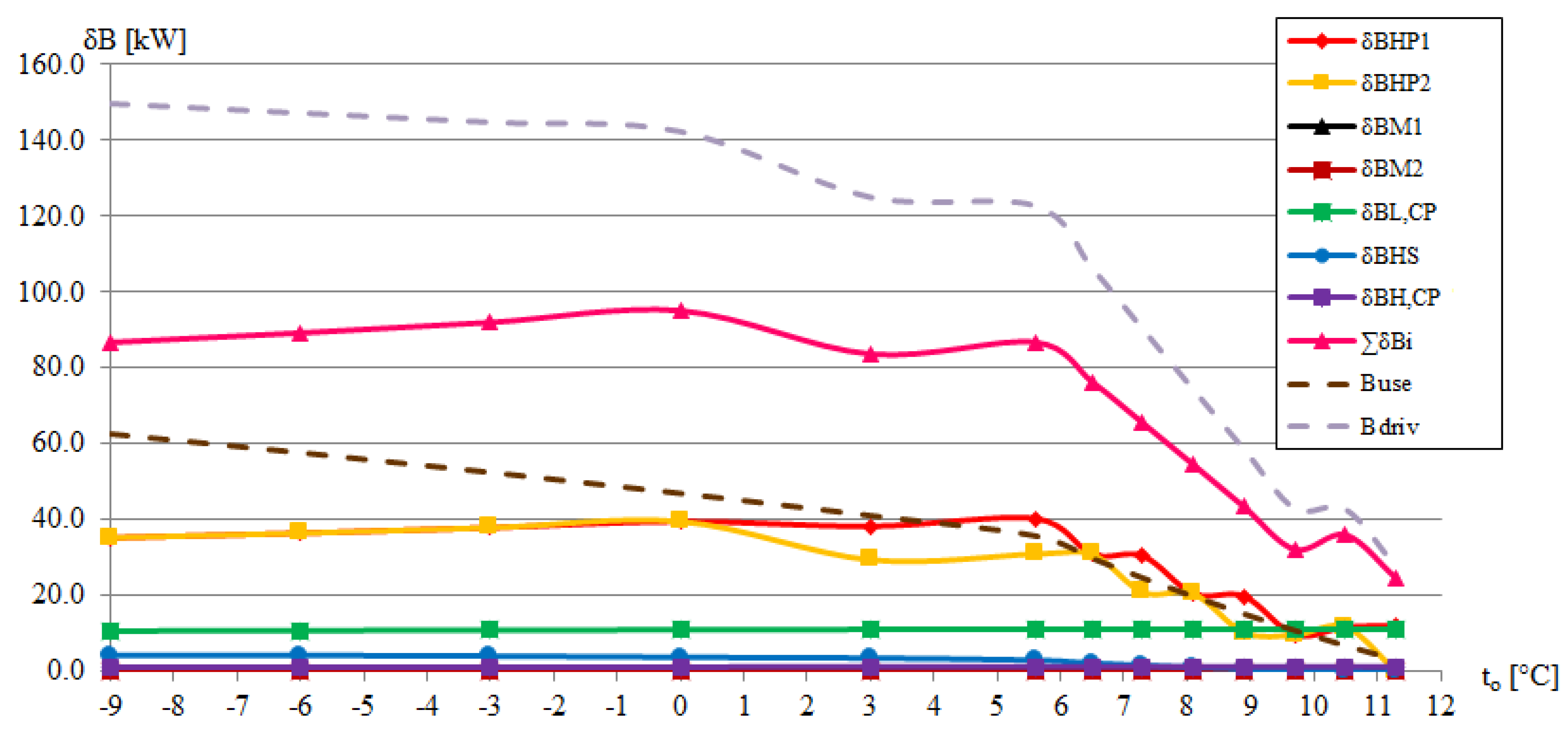
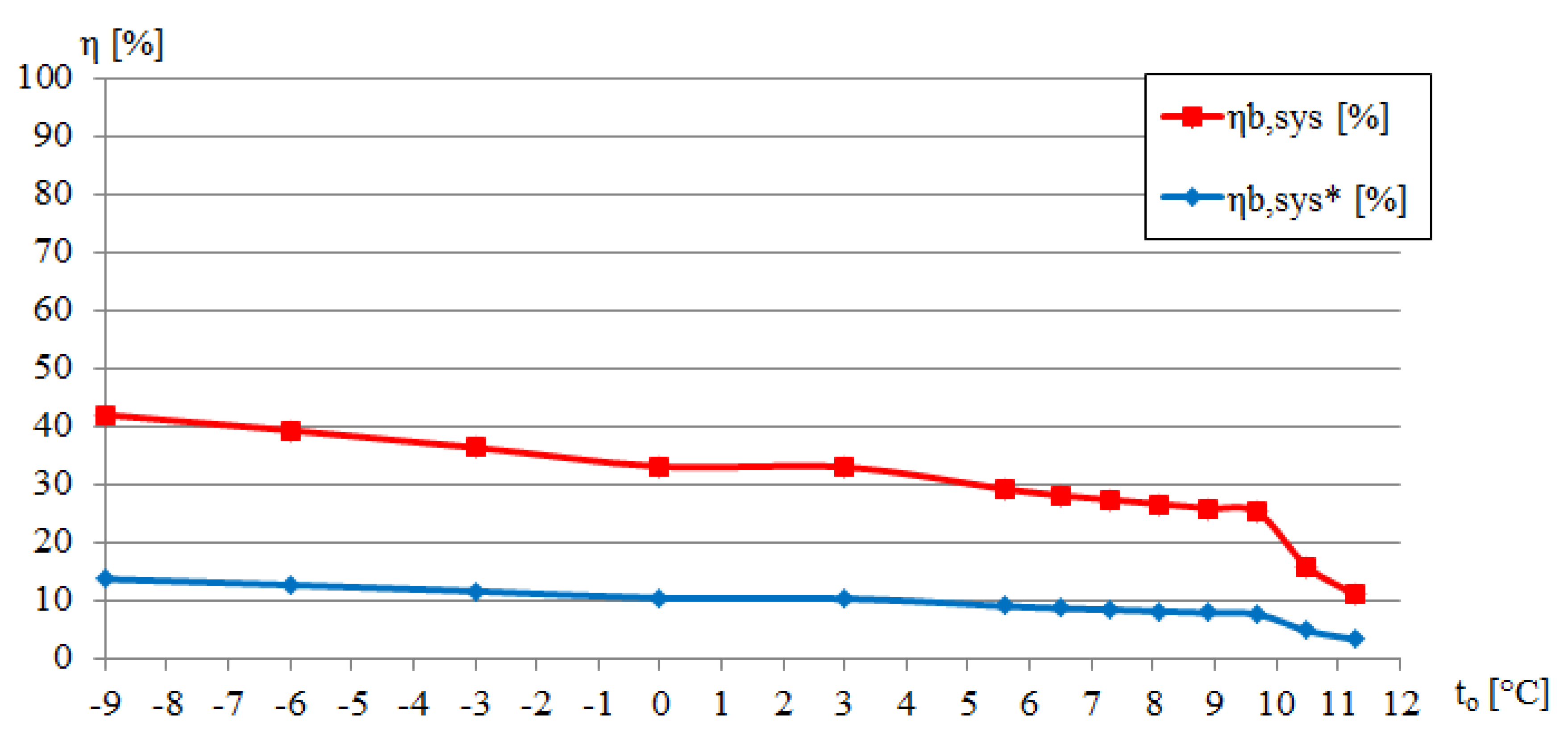
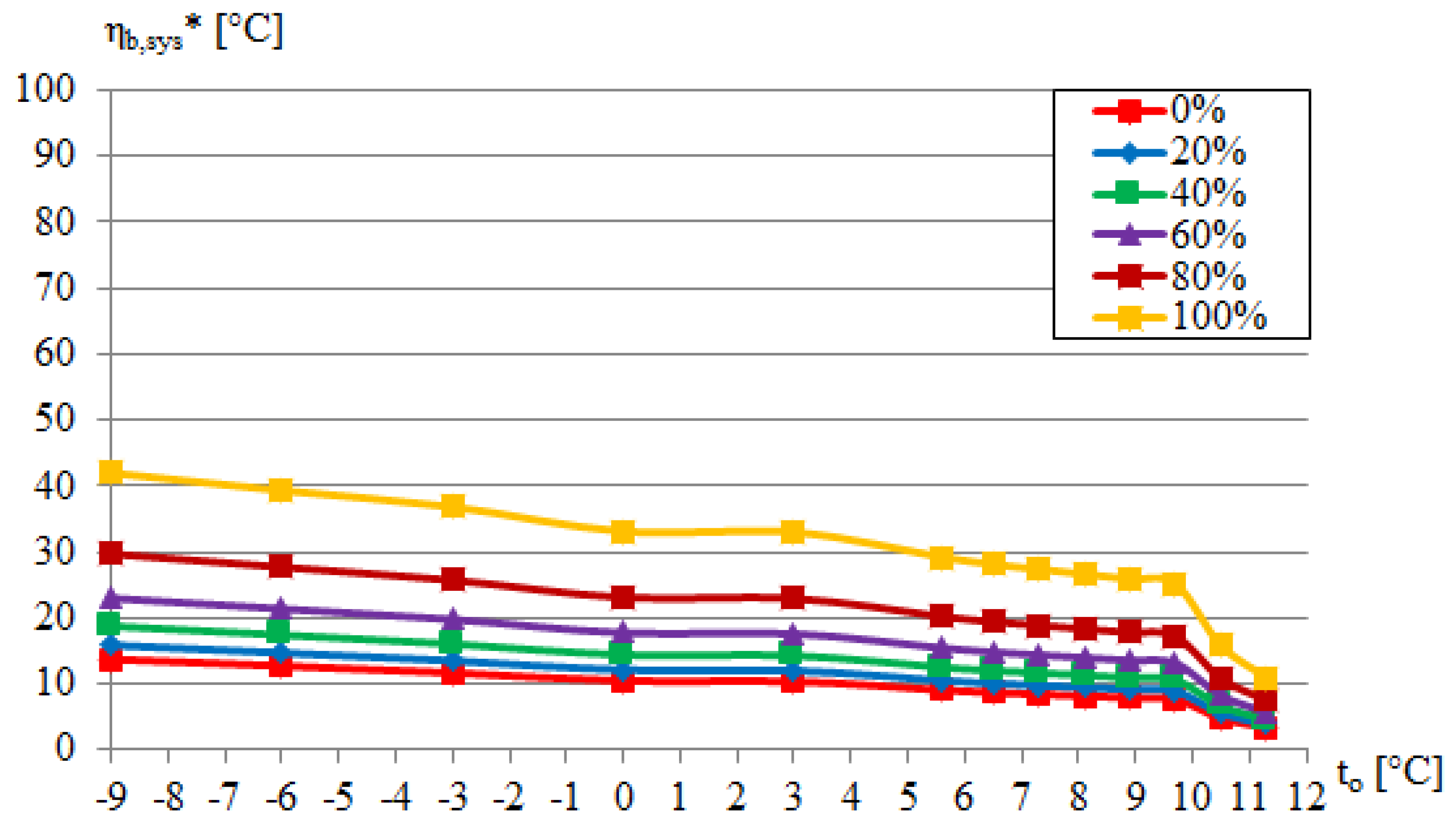
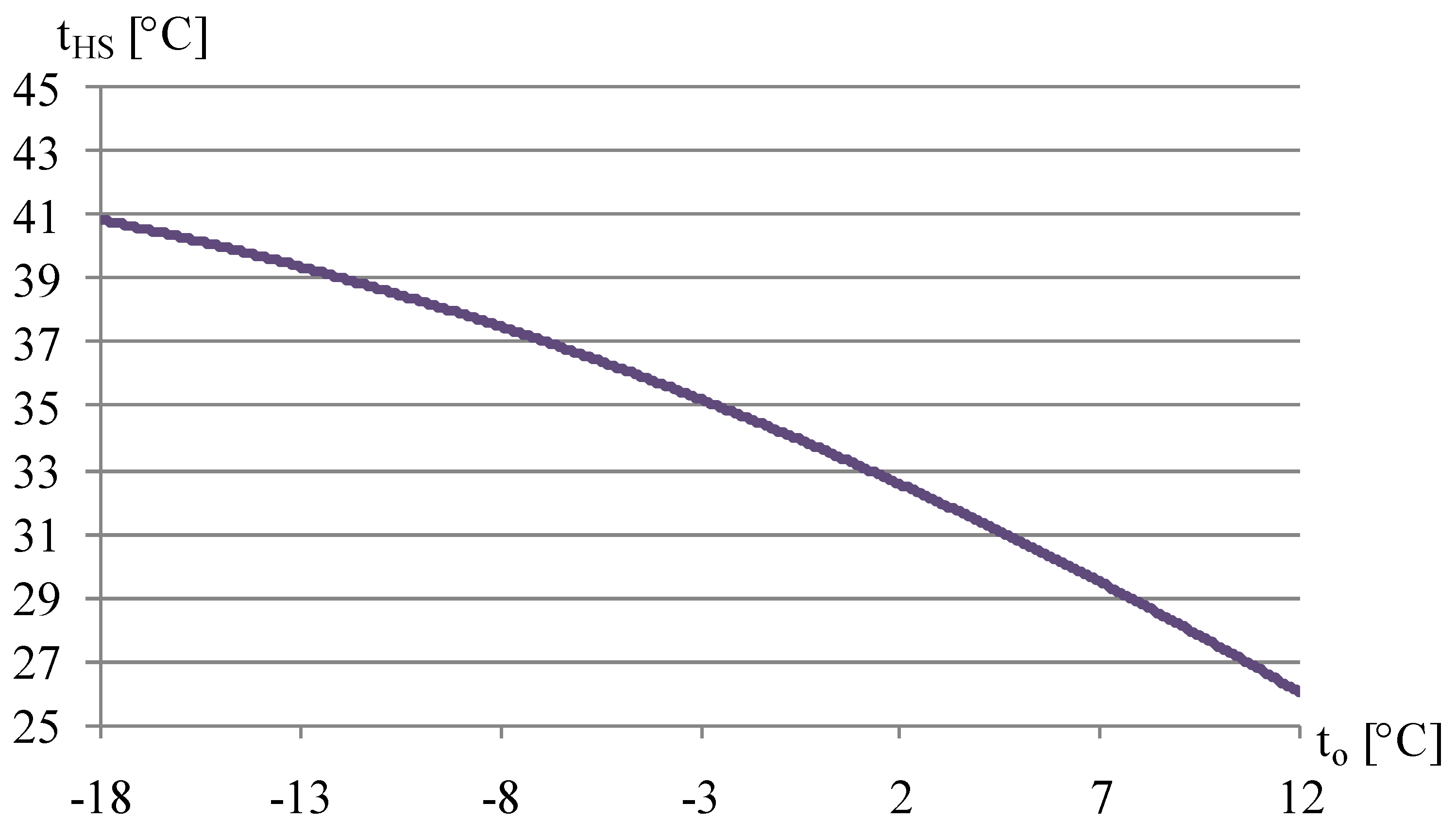
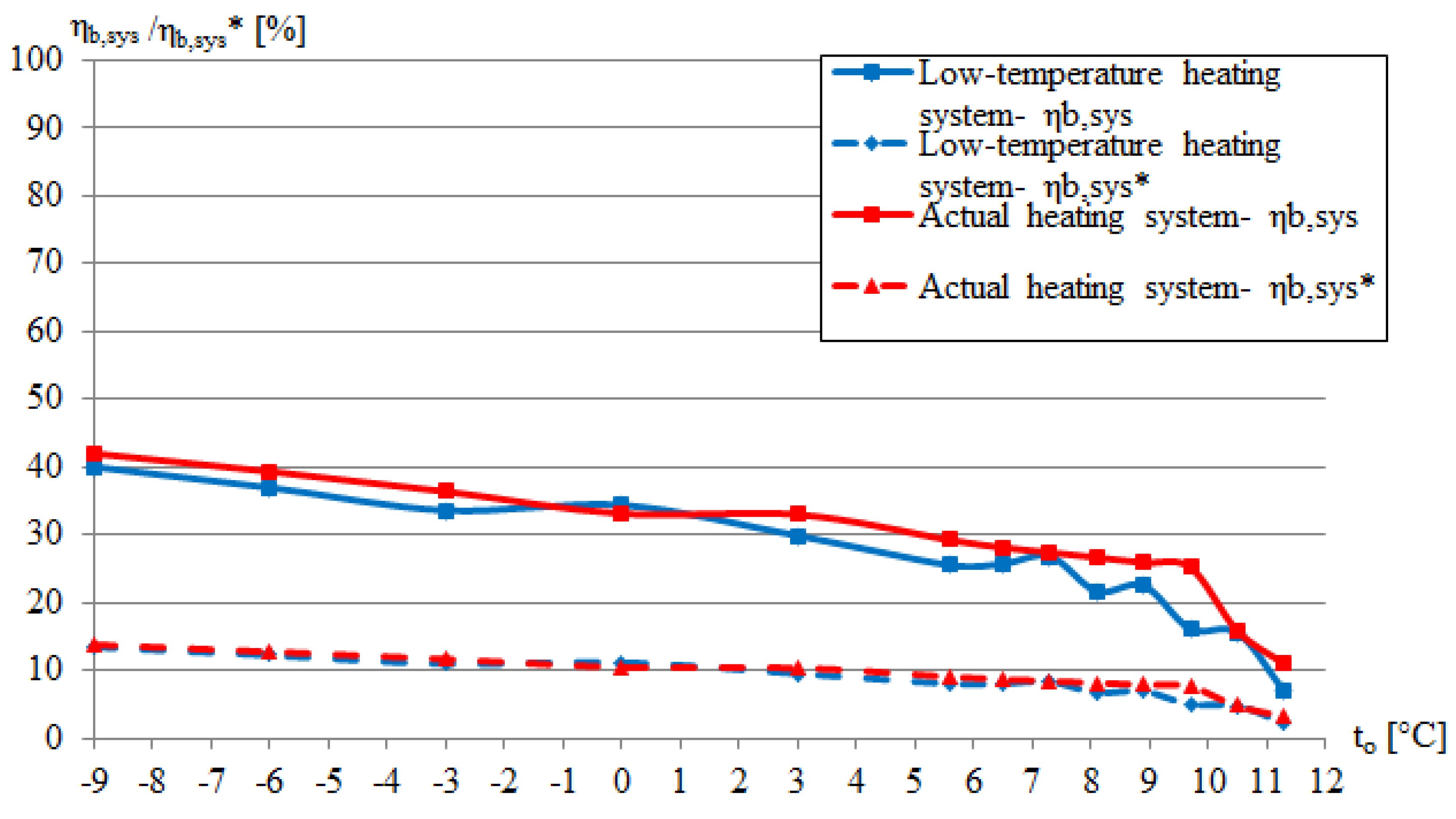
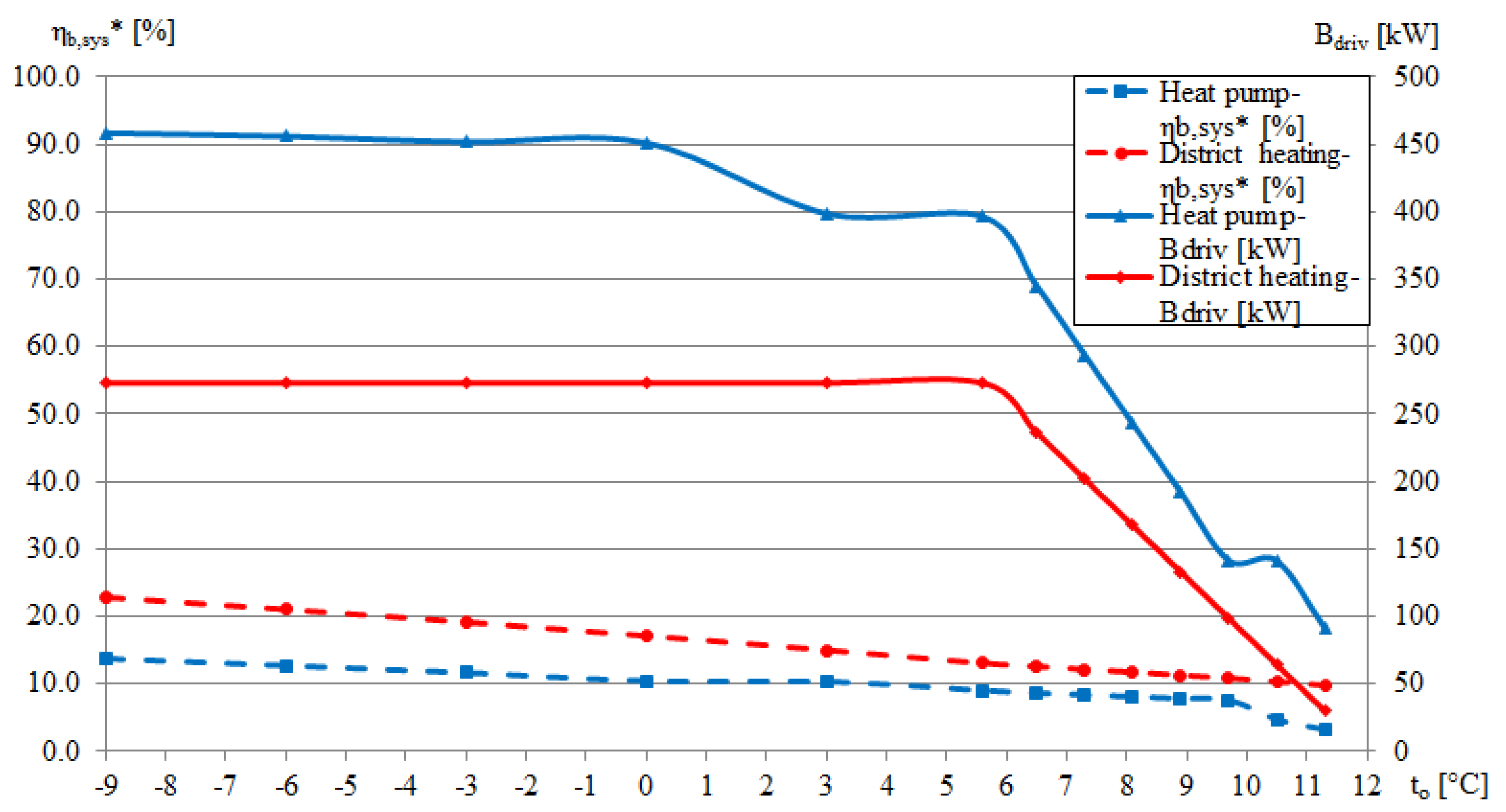
| Compressor | Condenser |
| Expansion Valve | Evaporator |
| Device | Quantity | Design Characteristics |
|---|---|---|
| Heat Pump Unit | 2 | Heating capacity: 175 kW, Input power: 60.8 kW, 4 compressors on/off mode |
| Primary circuit circulation pump | 1 | Flow rate: 89.5 m3/h, Input power: 11.1 kW, Constant speed |
| Secondary circuit circulation pump | 1 | Flow rate: 32.7 m3/h, Input power: 1.3 kW, Constant speed |
| Control Volume | Name of the System Component | Exergy Entering the CV (W) | Exergy Leaving the CV (W) |
|---|---|---|---|
| CV1-HP1 | Heat pump 1 | ||
| CV2-HP2 | Heat pump 2 | ||
| CV3-M1 | Mixing of heating water supplying the heating system | ||
| CV4-M2 | Mixing of the heat transfer medium returning to the heat source | ||
| CV5-L,CP | Circulating pump in the primary circuit | ||
| CV6-H,CP | Circulating pump in the secondary circuit | ||
| CV7-HS | Ground heat exchanger |
| Outdoor Temperature | Total Heating Load | Heating Power of the Heat Pumps | Coefficient of Performance | Power of the Compressors Working in the HP1 | Power of the Compressors Working in the HP2 | Temperature of the Heat Transfer Medium Entering the Evaporator | Temperature of the Heat Transfer Medium Leaving the Circulation Pump | Heat Exchanged with the Heat Source (Ground) | Temperature of the Heating Water Leaving the Circulating Pump | Temperature of the Heating Water Entering the Condenser |
|---|---|---|---|---|---|---|---|---|---|---|
| to (°C) | Qg (kW) | QH (kW) | COP (-) | NCOMP1 (kW) | NCOMP2 (kW) | tLS (°C) | tLR (°C) | QL (kW) | tHS’ (°C) | tHR (°C) |
| −9 | 1155.6 | 350.0 | 2.52 | 60.8 | 60.8 | 5.8 | 3.12 | 230.5 | 53.3 | 44.1 |
| −6 | 990.5 | 350.0 | 2.68 | 60.8 | 60.8 | 5.9 | 3.22 | 230.5 | 51.5 | 42.3 |
| −3 | 825.4 | 350.0 | 2.87 | 60.8 | 60.8 | 6.2 | 3.50 | 230.5 | 49.4 | 40.2 |
| 0 | 660.3 | 350.0 | 3.12 | 60.8 | 60.8 | 6.7 | 3.96 | 230.5 | 47.0 | 37.8 |
| 3 | 495.2 | 350.0 | 3.43 | 60.8 | 45.6 | 7.3 | 4.43 | 244.1 | 44.4 | 35.2 |
| 5.6 | 352.2 | 350.0 | 3.78 | 60.8 | 45.6 | 8.0 | 5.13 | 244.1 | 42.0 | 32.8 |
| 6.5 | 302.6 | 302.6 | 3.93 | 45.6 | 45.6 | 8.3 | 5.80 | 210.5 | 41.1 | 33.1 |
| 7.3 | 258.6 | 258.6 | 4.05 | 45.6 | 30.4 | 8.5 | 6.42 | 180.1 | 40.3 | 33.5 |
| 8.1 | 214.6 | 214.6 | 4.22 | 30.4 | 30.4 | 8.8 | 7.05 | 149.8 | 39.5 | 33.8 |
| 8.9 | 170.6 | 170.6 | 4.37 | 30.4 | 15.2 | 9.1 | 7.69 | 119.4 | 38.6 | 34.1 |
| 9.7 | 126.6 | 126.6 | 4.55 | 15.2 | 15.2 | 9.4 | 8.34 | 89.1 | 37.7 | 34.4 |
| 10.5 | 82.5 | 82.5 | 4.74 | 15.2 | 15.2 | 9.7 | 9.17 | 45.1 | 36.9 | 34.7 |
| 11.3 | 38.5 | 38.5 | 4.95 | 15.2 | 0 | 10.0 | 9.8 | 14.7 | 36.0 | 34.9 |
| Outdoor Temperature | Heat Pump 1 | Heat Pump 2 | Mixing 1 | Mixing 2 | Circulating Pump in the Primary Circuit | Ground Heat Exchanger | Circulating Pump in the Secondary Circuit |
|---|---|---|---|---|---|---|---|
| to (°C) | δBHP1 (W) | δBHP2 (W) | δBM1 (W) | δBM2 (W) | δBL,CP (W) | δBHS (W) | δBH,CP (W) |
| −9.0 | 35,241.8 | 35,241.8 | 206.5 | 0.0 | 10,668.4 | 4278.7 | 1117.5 |
| −6.0 | 36,448.4 | 36,448.4 | 191.5 | 0.0 | 10,774.8 | 4248.2 | 1132.5 |
| −3.0 | 37,878.0 | 37,878.0 | 175.7 | 0.0 | 10,874.6 | 4070.9 | 1148.3 |
| 0.0 | 39,541.9 | 39,541.9 | 158.9 | 0.0 | 10,967.7 | 3742.7 | 1165.1 |
| 3.0 | 38,250.2 | 29,404.5 | 231.1 | 27.9 | 11,059.9 | 3524.0 | 1182.8 |
| 5.6 | 40,317.5 | 30,969.7 | 217.1 | 28.1 | 11,129.1 | 2947.1 | 1199.1 |
| 6.5 | 30,858.4 | 30,858.4 | 119.1 | 0.0 | 11,137.4 | 2193.4 | 1204.9 |
| 7.3 | 30,444.3 | 20,825.8 | 214.2 | 30.7 | 11,144.0 | 1602.0 | 1210.2 |
| 8.1 | 20,449.6 | 20,449.6 | 108.5 | 0.0 | 11,150.2 | 1096.0 | 1215.5 |
| 8.9 | 19,805.4 | 10,230.3 | 226.4 | 39.4 | 11,155.8 | 679.8 | 1220.9 |
| 9.7 | 9643.3 | 9643.3 | 97.6 | 0.0 | 11,161.0 | 357.8 | 1226.4 |
| 10.5 | 11,712.7 | 11,712.7 | 92.0 | 0.0 | 11,159.8 | 90.3 | 1232.0 |
| 11.3 | 11,988.5 | 0.0 | 144.3 | 13.0 | 11,164.0 | 3.4 | 1237.7 |
© 2019 by the authors. Licensee MDPI, Basel, Switzerland. This article is an open access article distributed under the terms and conditions of the Creative Commons Attribution (CC BY) license (http://creativecommons.org/licenses/by/4.0/).
Share and Cite
Rijs, A.; Mróz, T. Exergy Evaluation of a Heat Supply System with Vapor Compression Heat Pumps. Energies 2019, 12, 1028. https://doi.org/10.3390/en12061028
Rijs A, Mróz T. Exergy Evaluation of a Heat Supply System with Vapor Compression Heat Pumps. Energies. 2019; 12(6):1028. https://doi.org/10.3390/en12061028
Chicago/Turabian StyleRijs, Agata, and Tomasz Mróz. 2019. "Exergy Evaluation of a Heat Supply System with Vapor Compression Heat Pumps" Energies 12, no. 6: 1028. https://doi.org/10.3390/en12061028
APA StyleRijs, A., & Mróz, T. (2019). Exergy Evaluation of a Heat Supply System with Vapor Compression Heat Pumps. Energies, 12(6), 1028. https://doi.org/10.3390/en12061028






